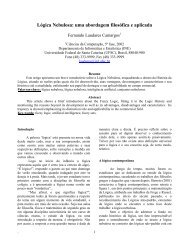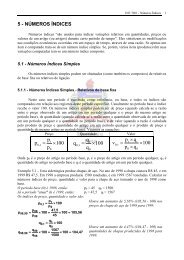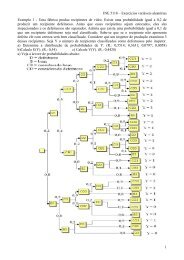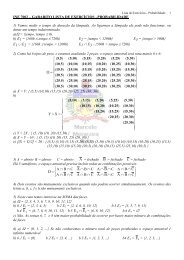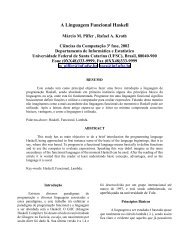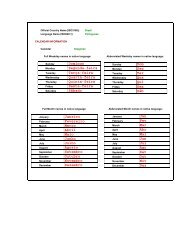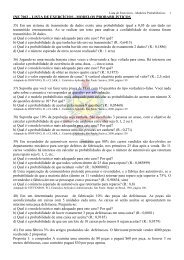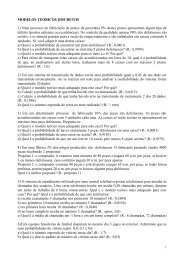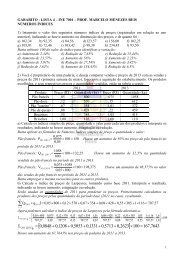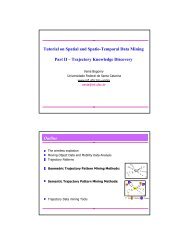Anais do IHC'2001 - Departamento de Informática e Estatística - UFSC
Anais do IHC'2001 - Departamento de Informática e Estatística - UFSC
Anais do IHC'2001 - Departamento de Informática e Estatística - UFSC
You also want an ePaper? Increase the reach of your titles
YUMPU automatically turns print PDFs into web optimized ePapers that Google loves.
80<br />
<strong>Anais</strong> <strong>do</strong> IHC’2001 - IV Workshop sobre Fatores Humanos em Sistemas Computacionais<br />
reaching, after the third evaluator, 47 problems (39,2% of the total problems <strong>de</strong>tected). To<br />
reach this level, it was necessary to assign seven software engineers. The Non_E_Heu<br />
curve implies that, even adding more evaluators, the number of problems <strong>de</strong>tected by the<br />
UE_Heu group would not be equalled.<br />
Comparing the UE curves until the third evaluator, it was verified that both groups<br />
reached the same number of problems at this point. The software engineers, on the other<br />
hand, found a larger number of usability problems when using the In<strong>de</strong>x method.<br />
Average severity of usability problems i<strong>de</strong>ntified by each method<br />
Table 4 shows the average severity, in a scale from 0 to 3, of the usability problems found<br />
by each group. There was a convergence to mo<strong>de</strong>rate severity. The In<strong>de</strong>x groups, however,<br />
reached a lower average severity, around 1,4. This finding is in accordance with Jeffries et<br />
al. (1991), whose study points, as a disadvantage of inspections based on gui<strong>de</strong>lines (or<br />
checklists), the fact that they miss many high severity problems, when compared to<br />
heuristic evaluation, for example. Among the In<strong>de</strong>x groups, the software engineers found a<br />
larger number of high severity problems (Table 5).<br />
Non_E<br />
_ISO<br />
Non_E<br />
_Cntl<br />
Table 4 – Average severity.<br />
Non_E<br />
_EC<br />
Non_E<br />
_Heu<br />
SE_<br />
Heu<br />
UE_<br />
Heu<br />
Non_E<br />
_In<strong>de</strong>x<br />
SE_In<strong>de</strong>x UE_In<strong>de</strong>x<br />
Average severity 1,8 1,72 1,75 1,74 1,6 1,72 1,4 1,4 1,37<br />
Total of 18 high<br />
severity problems<br />
Number of high<br />
severity problems<br />
Table 5 – I<strong>de</strong>ntification of high severity problems.<br />
Non_E<br />
_ISO<br />
Non_E<br />
_Cntl<br />
Non_E<br />
_EC<br />
Non_E<br />
_Heu<br />
SE_<br />
Heu<br />
UE_<br />
Heu<br />
Non_E<br />
_In<strong>de</strong>x<br />
SE_In<strong>de</strong>x UE_In<strong>de</strong>x<br />
4 6 4 9 7 10 5 7 6<br />
Consi<strong>de</strong>ring the 18 high severity problems (Table 5), rated by all evaluators, the<br />
UE_Heu group was the one that <strong>de</strong>tected the largest number, surpassing the In<strong>de</strong>x group of<br />
software engineers, that found the largest number of problems in total (Table 2).<br />
Comparing only non-expert evaluators, the Heuristics group was also the one that<br />
reached the largest number of problems in this range (50% of the high severity problems<br />
<strong>de</strong>tected by all groups), while the ISO and EC groups i<strong>de</strong>ntified only four. One evaluator<br />
of the Non_E_Heu group found 5 severe problems, a performance comparable or superior<br />
to the total number of severe problems <strong>de</strong>tected by Non_E_ISO, EC and In<strong>de</strong>x groups (4, 4<br />
and 5, respectively).<br />
Taking into account the behavior of the aggregates’ curves for high severity<br />
problems, this study also observed that there was a certain resemblance between groups<br />
using the same method in relation to slope and stability points, similarly to what happened<br />
with the total of usability problems, shown in Figure 1.



